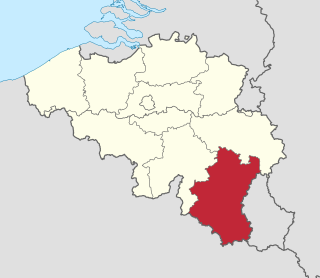
Luxembourg, also called Belgian Luxembourg or West Luxembourg, is the southernmost province of Wallonia within Belgium. It borders the country of Luxembourg to the east, the French departments of Ardennes, Meuse and Meurthe-et-Moselle to the south and southwest, and the Walloon provinces of Namur and Liège to the north. Its capital and largest city is Arlon, in the south-east of the province, near the border of the Grand Duchy of Luxembourg.
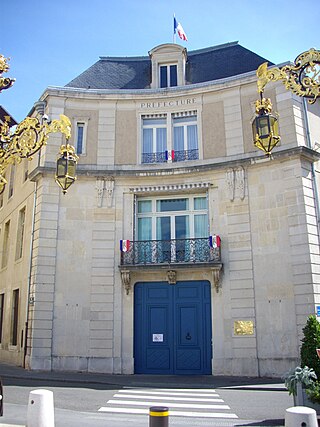
Meurthe-et-Moselle is a département in the Grand Est region of France, named after the rivers Meurthe and Moselle. Its prefecture and largest city is Nancy and it borders the departments of Meuse to the west, Vosges to the south, Moselle and Bas-Rhin and it borders the Belgian province of Luxembourg and the country of Luxembourg by the canton of Esch-sur-Alzette to the north. It had a population of 733,760 in 2019.

Aubange is a city and municipality of Wallonia located in the province of Luxembourg, Belgium.

Messancy is a municipality of Wallonia located in the province of Luxembourg, Belgium.

Musson is a municipality of Wallonia located in the province of Luxembourg, Belgium.
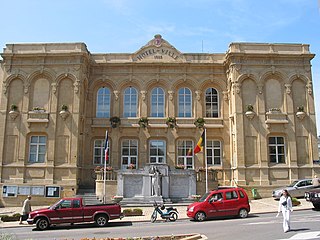
Virton is a city and municipality of Wallonia located in the province of Luxembourg, Belgium. It is also the administrative centre of the district (arrondissement) of the same name, as well as the principal town of the small region of Belgian Lorraine known as the Gaume, famous for its microclimate.

Gaume is a region in the extreme southeast of Belgium. At a lower altitude than the Ardennes, it borders the French region of Lorraine to the south, the Land of Arlon to the east, and the Belgian part of the Ardennes to the north.

Forêts was a department of the French First Republic, and later the First French Empire, in present-day Belgium, Luxembourg, and Germany. Its name, meaning 'forests', comes from the Ardennes forests. It was formed on 24 October 1795, after the Austrian Netherlands had been annexed by France on 1 October. Before annexation, the territory was part of the Duchy of Luxembourg and small parts of the Duchy of Bouillon. Its capital was Luxembourg City.

Royal Excelsior Virton is a Belgian football club, based in the city of Virton, in Luxembourg province. The club will participate in Belgian National Division 1 from 2023 to 2024 after relegation from Challenger Pro League in 2022–23. They were purchased by Al-Ittihad midfielder N'Golo Kanté on 30 June 2023.

The Arrondissement of Arlon is one of the five administrative arrondissements in the Walloon province of Luxembourg, Belgium. It is an administrative arrondissement not to be confused with the exctint judicial arrondissement of Arlon, also comprising the municipalities of the Arrondissement of Virton.
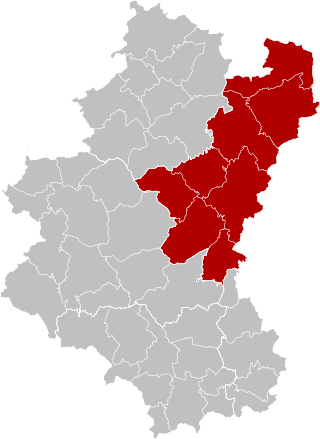
The Arrondissement of Bastogne is one of the five administrative arrondissements in the Walloon province of Luxembourg, Belgium. It is not a judicial arrondissement. Three of its municipalities, Gouvy, Houffalize and Vielsalm, are part of the Judicial Arrondissement of Marche-en-Famenne, while the rest of its municipalities are part of the Judicial Arrondissement of Neufchâteau.

The Arrondissement of Marche-en-Famenne is one of the five administrative arrondissements in the Walloon province of Luxembourg, Belgium. It is both an administrative and a judicial arrondissement. However, the Judicial Arrondissement of Marche-en-Famenne also comprises the municipalities of Gouvy, Houffalize and Vielsalm in the Arrondissement of Bastogne.
Aurélien Joachim is a professional footballer who plays for RUS Ethe Belmont as a striker. Born in Belgium, he made 80 appearances for the Luxembourg scoring 15 goals between 2005 and 2019. He is the younger brother of former cyclist Benoît Joachim.
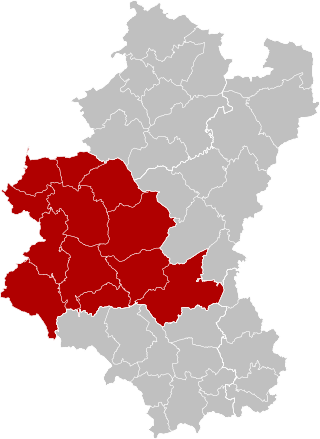
The Arrondissement of Neufchâteau is one of the five administrative arrondissements in the Walloon province of Luxembourg, Belgium. It is both an administrative and a judicial arrondissement. However, the Judicial Arrondissement of Neufchâteau also comprises the municipalities of Bastogne, Bertogne, Fauvillers, Sainte-Ode and Vaux-sur-Sûre in the Arrondissement of Bastogne.

Belgian Lorraine is the part of Lorraine that lies in the south of the Belgian province of Luxembourg, in Wallonia.

Partial general elections were held in Belgium on 13 June 1876. In the elections for the Chamber of Representatives the result was a victory for the Catholic Party, which won 67 of the 124 seats. Voter turnout was 67.5%, although only 63,278 people were eligible to vote.

Virton railway station is a railway station in Virton, Luxembourg, Belgium. It is located on railway line 165, from Athus to Libramont. It was commissioned in 1879 by the Society of Railway Virton, and was formerly called Virton-Saint-Mard railway station. It is operated by the National Railway Company of Belgium (SNCB/NMBS) and served by the following types of trains: Omnibus (L) and Rush Hour trains (P).
Arlon-Marche-Bastogne was a parliamentary constituency in Belgium used to elect members of the Walloon Parliament from 1995 until 2019. It corresponds to the arrondissements of Arlon, Marche-en-Famenne and Bastogne.
Neufchâteau-Virton was a parliamentary constituency in Belgium used to elect members of the Walloon Parliament from 1995 until 2019. It corresponds to the arrondissements of Neufchâteau and Virton.

Arlon-Marche-en-Famenne-Bastogne-Neufchâteau-Virton is a parliamentary constituency in Belgium used to elect members of the Parliament of Wallonia from 2019. It corresponds to the province of Luxembourg. It was created from the former constituencies of Arlon-Marche-Bastogne and Neufchâteau-Virton and was first contested for the 2019 Belgian regional elections.

















